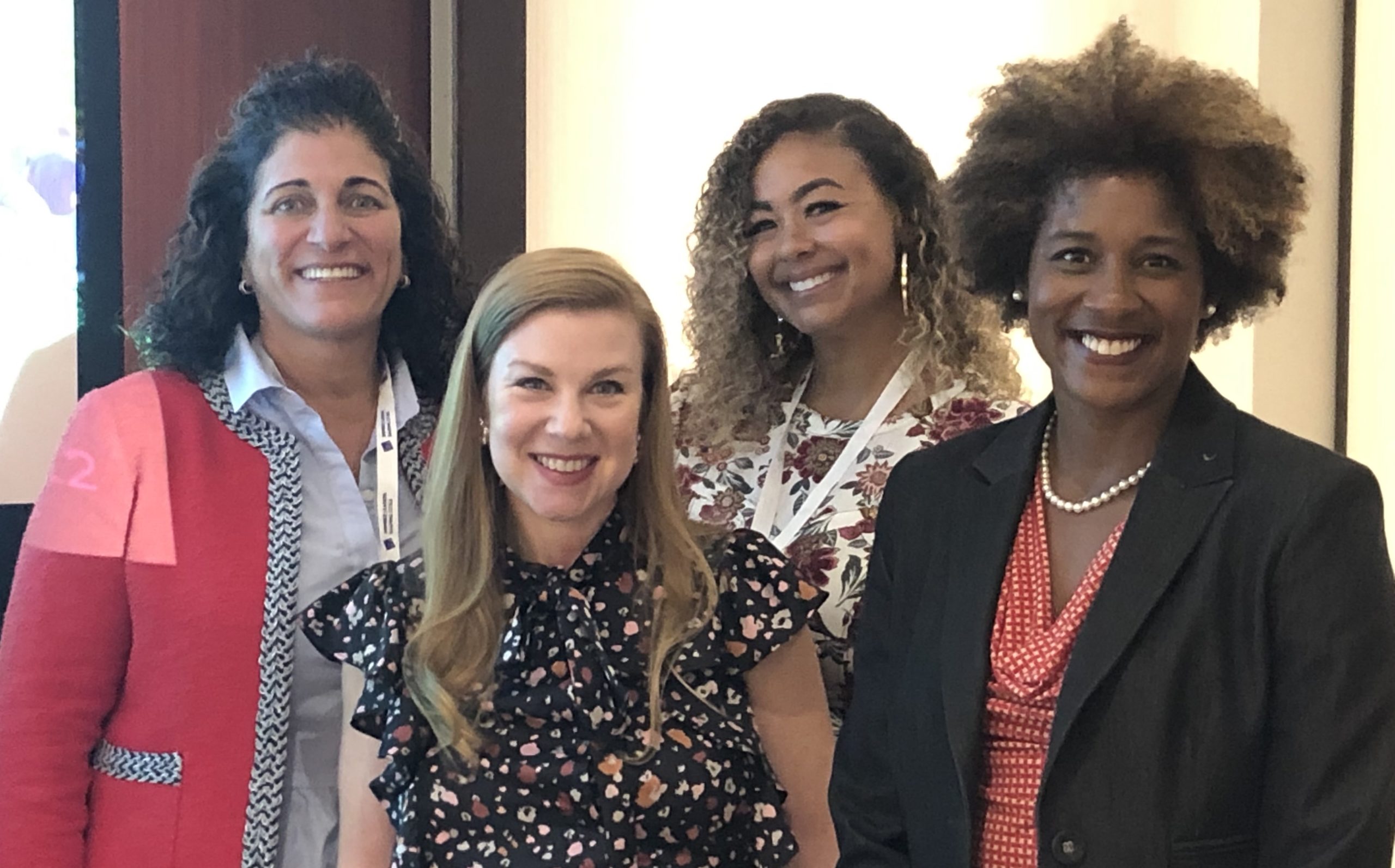
Over the past 15+ years, the Levitt Foundation has partnered with communities of all sizes to help bring thousands of free concerts to towns and cities across the nation, harnessing the power of live music to reinvigorate public spaces and strengthen the social fabric of communities by bringing people together of all ages and backgrounds. Throughout this time, the Foundation has been committed to sharing the Levitt mission as a vehicle for positive change in communities. In addition to providing grants to nonprofits and funding research that examines the social impact of Levitt programs, the Foundation spreads the word at conferences and events spanning a wide range of sectors, including the arts, community development, parks, and philanthropy, to help foster cross-sector dialogue and inspire more people to prioritize arts investments in creating equitable, healthy, and thriving communities. As a leading voice at the intersection of the arts, public space, and community building, the Foundation has been invited to present at dozens of conferences across the country—in 2022 these included Exponent Philanthropy in Minneapolis, Grantmakers in the Arts in New York City, and the Music Cities Convention in Tulsa, to name a few.
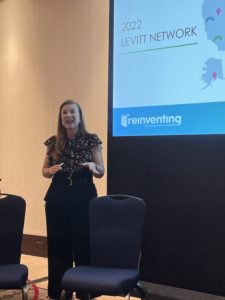
Sharon Yazowski shares the Levitt Foundation mission.
Earlier this fall, Levitt Foundation Executive Director Sharon Yazowski, alongside three nonprofit grantees from across the Levitt network representing small- to medium-sized cities, spoke to the impact of their work during a panel discussion at the International Downtown Association’s 68th Annual Conference & Marketplace in Vancouver, British Columbia. Organized around the theme “Reinventing: The Communities of Tomorrow,” the conference attracted more than 950 leaders from around the world to discuss trends and best practices in urban place management.
As we have seen across the Levitt network, arts investment strategies in public spaces play a key role in enlivening downtown districts—sparking economic activity, renewing greenspaces, and creating a shared sense of community across the many demographic groups who call a particular place home.
Along with Yazowski, speaking to this mission as a way to create more equitable downtowns were Talicia Richardson, Executive Director of the downtown association 64.6 Downtown (which presents the Levitt AMP Music Series in Fort Smith, Ark.); Lisa Wagner, Executive Director of Levitt Pavilion Dayton (Ohio); and Jamie Haack, Director of Diversity, Equity & Inclusion at the John Michael Kohler Arts Center (presenter of the Levitt AMP Music Series in Sheboygan, Wis.).
At the panel, “Advancing Equity While Building Thriving Downtowns,” presenters spoke about how free Levitt concerts have made a positive impact in their communities, and how they have approached the process of putting together the music series through the lens of equity and involving the community every step of the way. This includes identifying community leaders and key stakeholders among the various groups that comprise a city’s population; the importance of earning trust to develop authentic partnerships; and meeting people where they are to encourage historically underrepresented populations to feel welcome and engaged. The panel also included a conversation around approaches to nurturing and revitalizing public spaces in order to contribute to thriving downtowns.
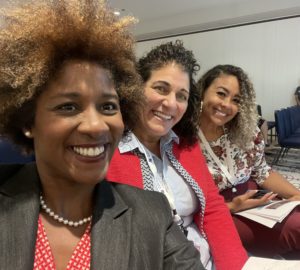
Talicia Richardson, Lisa Wagner, and Jamie Haack serve as panelists at the IDA Conference.
“Presenting at IDA this year was particularly gratifying to be able to share the impact of Levitt programs in creating more inclusive downtown districts,” Yazowski says. “While Sheboygan, Fort Smith, and Dayton are each unique in their own right, there is a through line in their approaches to community building, and the lessons learned from their placemaking efforts are applicable to towns and cities of any size seeking to use the arts and inclusionary practices as vehicles for building social cohesion, a sense of belonging, and creating equitable public spaces.”
Each presenter outlined different ways to create more equitable downtowns: increasing economic opportunity; designing more inclusive spaces; and programming the spaces to be reflective of the communities they serve.
Richardson, whose organization presents the Levitt AMP Fort Smith Music Series in Riverfront Park along the Arkansas River, addressed her work through the lens of economic opportunity. As executive director of 64.6 Downtown, Richardson was already active in arts investments strategies, having launched a series of downtown endeavors to engage the wider community—including a celebrated public mural project featuring international artists and a museum exhibition featuring rarely seen artifacts from the city’s Black community—and saw the potential of a free outdoor music series to build upon this work. Richardson and her team looked at every aspect of how a music series comes to life, and asked how the series could help uplift local businesses in the community, including ones that are BIPOC-owned. For Richardson, a key takeaway when it comes to deepening her organization’s commitment to EDI is the importance of engaging a range of community groups across a variety of different fronts, from outreach to audiences on the lawn to determining who are the vendors.
“That means meeting people where they are,” Richardson said, “and not just knocking on their doors when we need something or want something, but instead saying, ‘hey, we’re having this music series, we want you to participate, and by the way I understand you have this type of business, and we’re in need of this service or good.’ That combines community engagement with economic development.”
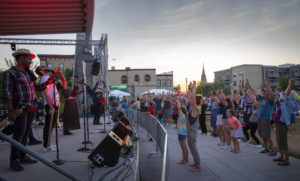
Concert night at Levitt AMP Sheboygan.
For Haack of the Levitt AMP Sheboygan Music Series, the design of the physical space, including its layout, is also mission critical to creating an inclusive, welcoming atmosphere. She explained the use of “cultural asset mapping” (identifying a community’s assets in the form of places, people, and organizations) to inform planning for their Levitt AMP Music Series, which takes place in the city’s downtown at City Green. Through this process, they reimagined portions of the site and the design of facilities and vendor spaces to be as inclusive as possible. In particular, Haack discussed the ways that the sober community could be made to feel more welcome at community events like Levitt AMP. Since outdoor concerts are often associated with alcohol, sober community members may be dissuaded from attending; Haack discussed ways to design the space to be more inclusive, including by engaging with vendors to create mocktails to enhance the quality of nonalcoholic beverage options, and decentralizing the location of alcohol vendors during events to less prominent locations. She also discussed approaches to better serving neurodiverse audiences through strategic partnerships with organizations like the Autism Society of America to better understand their needs. For example, picnic tables at City Green were painted different colors to appeal to those with sensory sensitivity issues—not only did this allow Levitt AMP Sheboygan to be more inclusive to neurodiverse members of the community, the color choices also created a more lively, joyful space for all.
“Looking at site design, catering to one group often provides better experiences for many,” she shared.
For Wagner of Levitt Dayton, a key factor when booking musical artists is making sure that the Levitt Pavilion is living up to Dayton’s status as a certified “Welcoming City.” Culturally rich and home to a wealth of immigrant populations, openness and diversity are essential elements of Dayton’s DNA, so ensuring the venue’s programming is inclusive to all of the city’s communities has been a priority from day one. Curating 40–50 free concerts each summer in the city’s downtown core, Wagner and her team are committed to making sure that the artists onstage reflect Dayton’s diversity, and that the final word in planning culturally specific events rests with members of those cultures themselves. When planning Levitt Dayton’s 2022 Juneteenth celebration, for example, Wagner reached out to community members and engaged with local poet and author Sierra Leone to guide programming. “I’m not the expert,” Wagner recalled telling Leone. “Could you help me curate it?” The result was a multidisciplinary event that encompassed music, an educational panel, dance, and poetry.
“It was important that the community guided this event,” Wagner said.
Throughout the session, each of the panelists spoke to the importance of listening, letting others lead, humility, and openness in fostering EDI practices that create a space where people feel like their community is represented and welcome. As our country becomes increasingly diverse, building bridges among different cultural groups has taken on even greater urgency, and free concerts in public spaces are vital bridges to greater understanding and cohesion.
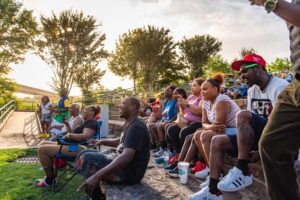
Community members gather at Levitt AMP Fort Smith.
“We feel that people want to embrace diversity, and it’s our role to foster a space for said diversity,” Richardson said. “This takes time and persistence on the part of the person who is extending the invitation.”
All four panelists recognized that building equity is a process; the work of building relationships within communities is ongoing. And programs like free Levitt concerts play a key role in advancing open dialogue. Together with Yazowski, Richardson, Haack, and Wagner shared their thoughtful and creative approaches for inclusive placemaking that acknowledge and respect existing community dynamics, develop authentic, reciprocal partnerships, foster trust and engagement, and empower a range of voices in order to create equitable, thriving downtowns. The session ended with robust dialogue during the audience Q&A, further revealing the multiple opportunities for downtown organizations to apply an EDI lens to their work, as well as inform the wider field of placemaking practitioners, nonprofits, and city and civic leaders. As the Levitt Foundation continues its work supporting communities, we’ll continue sharing the impact of Levitt programs on the conference stage, and in articles like these, to inspire more equitable, healthy, and thriving communities through arts investments.
